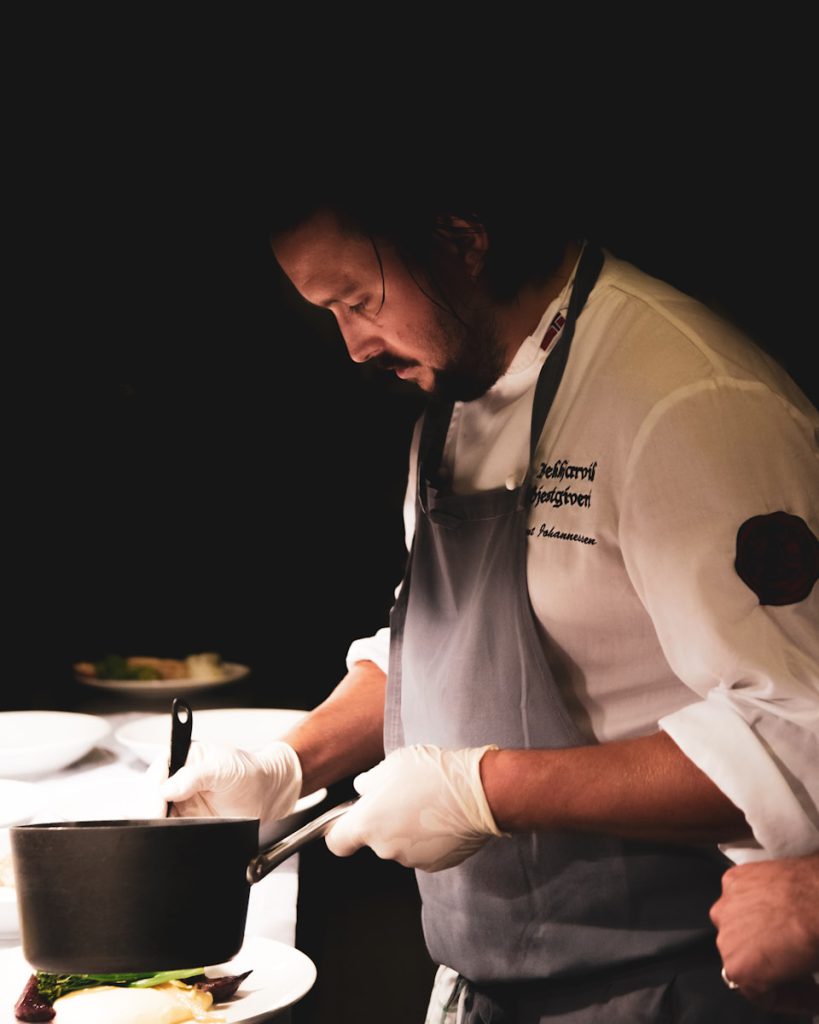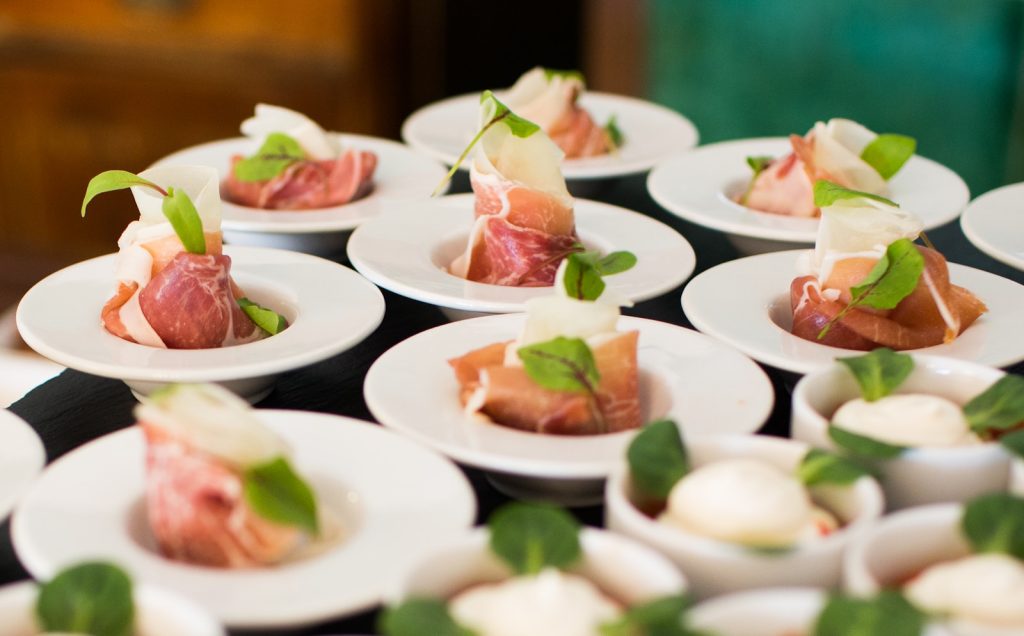Staying updated with the latest party catering trends is as crucial for event and party catering businesses looking to attract and satisfy clients as it is for customers who want to throw a trendy party. As tastes and preferences evolve, keeping an eye on emerging trends ensures that caterers can offer innovative and desirable options. This article delves into the top 10 party catering trends that are shaping the industry in 2024.
Trend 1: Sustainable Catering
Sustainable catering has become a significant trend as more clients prioritize eco-friendly practices. Catering businesses that adopt sustainable practices not only contribute to the environment but also appeal to the growing number of eco-conscious clients.
- Eco-Friendly Packaging: Utilizing biodegradable or reusable packaging materials.
- Locally Sourced Ingredients: Reducing carbon footprint by sourcing ingredients from local farms.
- Waste Reduction Practices: Implementing strategies to minimize food waste, such as composting and donating excess food.
Example: A catering company can offer bamboo cutlery and compostable plates, enhancing their appeal to eco-conscious clients.

Table: Benefits of Sustainable Catering
| Benefit | Description |
|---|---|
| Reduced Environmental Impact | Lower carbon footprint and less waste |
| Cost Savings | Efficient use of resources, less wastage |
| Positive Brand Image | Appeal to eco-conscious clients |
Trend 2: Plant-Based Menus
Plant-based menus are no longer just a niche offering; they are now mainstream. With the rise of vegetarianism, veganism, and flexitarianism, caterers are increasingly offering plant-based options that are delicious and nutritious.
- Popular Plant-Based Dishes: Including items such as lentil shepherd’s pie, quinoa salads, and vegetable stir-fries.
- Nutritional Benefits: Highlighting the health benefits of plant-based diets, such as lower cholesterol levels and reduced risk of chronic diseases.
- Client Testimonials: Sharing positive feedback from clients who enjoyed plant-based catering options.
Example: A wedding menu featuring a variety of plant-based hors d’oeuvres, main courses, and desserts.
Table: Popular Plant-Based Ingredients
| Ingredient | Use in Catering |
|---|---|
| Quinoa | Salads, bowls, and side dishes |
| Chickpeas | Hummus, stews, and salads |
| Tofu | Stir-fries, soups, and appetizers |
| Kale | Salads, chips, and smoothies |

Trend 3: Interactive Food Stations
Interactive food stations add an element of fun and engagement to events. They allow guests to customize their meals and enjoy freshly prepared dishes, enhancing the overall dining experience.
- Types of Interactive Stations: Examples include taco bars, sushi rolling stations, and build-your-own salad bars.
- Guest Engagement: How interactive stations encourage guests to interact with chefs and each other.
- Customization Options: Offering a variety of toppings and ingredients for guests to personalize their meals.
Example: A pasta station where guests can choose their type of pasta, sauce, and toppings, creating a personalized dish.
Table: Popular Interactive Food Stations
| Station Type | Description |
|---|---|
| Taco Bar | Guests customize tacos with various fillings |
| Sushi Rolling Station | Guests roll their own sushi with guidance |
| Salad Bar | Variety of greens, toppings, and dressings |
| Dessert Station | Customizable ice cream sundaes and toppings |
Trend 4: Global Cuisine
Global cuisine introduces diverse flavors and culinary traditions to catering menus. With the world becoming more connected, clients are eager to experience international dishes at their events.
- Popular Cuisines: Highlighting trending cuisines such as Thai, Mexican, and Mediterranean.
- Fusion Dishes: Combining elements from different culinary traditions to create unique offerings.
- Cultural Significance: Educating clients about the cultural background of the dishes.
Example: A Mediterranean buffet featuring hummus, falafel, tabbouleh, and baklava.
Table: Popular Global Dishes
| Cuisine | Popular Dishes |
|---|---|
| Thai | Pad Thai, Green Curry, Mango Sticky Rice |
| Mexican | Tacos, Guacamole, Churros |
| Mediterranean | Hummus, Falafel, Baklava |
| Indian | Samosas, Butter Chicken, Naan |

Trend 5: Health-Conscious Options
Health-conscious catering options cater to guests who prioritize their well-being. Offering nutritious and balanced meals ensures that guests can enjoy delicious food without compromising on their health goals.
- Healthy Ingredients: Incorporating superfoods, whole grains, and lean proteins.
- Special Dietary Needs: Catering to guests with dietary restrictions such as gluten-free, dairy-free, and low-carb diets.
- Presentation: Emphasizing the importance of visually appealing and appetizing presentations.
Example: A menu featuring quinoa bowls with grilled chicken, avocado, and a variety of fresh vegetables.
Table: Health-Conscious Ingredients
| Ingredient | Health Benefits |
|---|---|
| Quinoa | High in protein and fiber |
| Avocado | Rich in healthy fats and vitamins |
| Spinach | High in iron and antioxidants |
| Lean Chicken | Low in fat and high in protein |
Trend 6: Customizable Menus
Customizable menus provide clients with the flexibility to tailor their catering to suit their preferences and dietary needs. This trend ensures that every guest has a satisfying dining experience.
- Client Consultation: Working closely with clients to design a menu that meets their requirements.
- Flexible Options: Offering a range of dishes that can be adjusted for dietary restrictions and personal preferences.
- Guest Satisfaction: Ensuring that customisable menus enhance the overall guest experience.
Example: A wedding where guests can choose from multiple entrée options, including vegetarian, vegan, and gluten-free dishes.
Table: Customizable Menu Elements
| Element | Options Available |
|---|---|
| Entrées | Vegetarian, Vegan, Gluten-Free, Meat |
| Side Dishes | Rice, Quinoa, Mashed Potatoes, Steamed Veggies |
| Desserts | Dairy-Free, Sugar-Free, Nut-Free |
| Beverages | Alcoholic, Non-Alcoholic, Mocktails |

Trend 7: Artisanal and Craft Foods
Artisanal and craft foods emphasize quality, craftsmanship, and unique flavors. These foods are often made using traditional methods and high-quality ingredients, appealing to clients seeking authentic and gourmet experiences.
- Popular Artisanal Items: Examples include handmade cheeses, charcuterie, and craft beverages.
- Local Artisans: Partnering with local producers to source artisanal products.
- Presentation: Highlighting the importance of aesthetically pleasing presentations for artisanal foods.
Example: A cheese and charcuterie board featuring locally sourced cheeses, cured meats, and artisanal bread.
Table: Popular Artisanal and Craft Foods
| Food Type | Description |
|---|---|
| Cheeses | Handmade, aged, and specialty cheeses |
| Charcuterie | Cured meats, sausages, and pâtés |
| Craft Beverages | Locally brewed beers, craft cocktails, mocktails |
| Baked Goods | Artisan bread, pastries, and cakes |
Trend 8: Technology Integration
Integrating technology into catering services enhances efficiency, guest experience, and operational management. From online booking systems to mobile ordering apps, technology is revolutionizing the catering industry.
- Online Booking and Ordering: Streamlining the booking process with user-friendly online platforms.
- Event Management Software: Using software to manage logistics, guest lists, and seating arrangements.
- Interactive Menus: Offering digital menus with interactive features, such as ingredient information and dietary filters.
Example: A catering company using a mobile app for guests to place orders and customize their meals at an event.
Table: Technology Integration in Catering
| Technology | Benefits |
|---|---|
| Online Booking | Convenience, efficiency, and easy access |
| Event Management | Streamlined logistics, better coordination |
| Interactive Menus | Enhanced guest experience, dietary accommodations |
| Mobile Ordering | Faster service, reduced wait times |
Trend 9: Local and Seasonal Ingredients
Using local and seasonal ingredients ensures freshness and supports local farmers. This trend also appeals to clients who value sustainability and high-quality, flavorful food.
- Benefits of Local Sourcing: Fresher ingredients, reduced transportation emissions, and support for local economies.
- Seasonal Menu Planning: Designing menus based on the availability of seasonal produce.
- Client Education: Informing clients about the benefits and origins of local and seasonal ingredients.
Example: A summer menu featuring fresh berries, heirloom tomatoes, and locally caught seafood.
Table: Seasonal Ingredients
| Season | Ingredients |
|---|---|
| Spring | Asparagus, Strawberries, Peas |
| Summer | Berries, Tomatoes, Corn |
| Fall | Squash, Apples, Brussels Sprouts |
| Winter | Root Vegetables, Citrus Fruits, Kale |
Trend 10: Themed Catering
Themed catering adds an extra layer of excitement and personalization to events. By incorporating a specific theme, caterers can create a cohesive and memorable experience that aligns with the client’s vision.
- Popular Themes: Examples include tropical, vintage, and holiday-themed events.
- Decor and Presentation: Using themed decorations and presentation styles to enhance the dining experience.
- Menu Design: Creating menus that reflect the chosen theme, including themed food and beverage options.
Example: A tropical-themed party with tiki bars, Hawaiian cuisine, and vibrant decorations.
Table: Popular Catering Themes
| Theme | Elements |
|---|---|
| Tropical | Tiki bars, Hawaiian cuisine, tropical drinks |
| Vintage | Retro decor, classic dishes, nostalgic treats |
| Holiday | Seasonal decorations, festive foods, holiday drinks |
| Rustic | Farm-to-table dishes, natural decor, craft beverages |
Farm-to-Table Catering
The farm-to-table movement emphasizes transparency and traceability, with caterers showcasing the journey of ingredients from farm to plate. This trend aligns with consumer demand for authenticity and quality.
Why Farm-to-Table?
Farm-to-table catering ensures that ingredients are fresh, sustainably sourced, and free from excessive processing. It appeals to clients who value knowing where their food comes from and supports ethical and sustainable farming practices.
Key Practices
- Transparency: Provide information about the sourcing of ingredients.
- Quality Assurance: Use high-quality, ethically sourced ingredients.
- Engagement: Educate clients and guests about the benefits of farm-to-table practices.
Example: Farm-to-Table Menu
| Course | Dish | Source |
|---|---|---|
| Appetizer | Farm Fresh Crudités | Local farm produce |
| Main Course | Grass-Fed Beef Tenderloin | Nearby ranch |
| Dessert | Seasonal Fruit Tart | Local orchard |
Staying abreast of the latest party catering trends is essential for catering businesses looking to meet the evolving demands of their clients. By embracing trends such as sustainable practices, plant-based menus, interactive food stations, and themed events, caterers can offer unique and memorable experiences. Incorporating health-conscious options, customizable menus, artisanal foods, technology integration, and local ingredients further ensures that clients receive high-quality, innovative, and personalized services.
Innovative Food Presentations
Food presentation is key in making dishes visually appealing and enhancing the overall dining experience.
Why Innovative Presentations?
Creative presentations can make ordinary dishes extraordinary, adding an aesthetic element to the dining experience.
Key Presentation Practices
- Color and Texture: Use vibrant colors and varied textures.
- Unique Serving Methods: Serve dishes in unexpected ways (e.g., edible bowls).
- Thematic Displays: Align presentations with event themes.
Example: Innovative Presentations
| Dish | Presentation | Description |
|---|---|---|
| Salad | Served in Glass Jars | Layered salads in mason jars for a rustic look |
| Dessert | Miniature Desserts | Small portions served on a dessert platter |
| Appetizer | Skewered Bites | Bite-sized appetizers on skewers |
Sophisticated Mocktails and Non-Alcoholic Beverages
Mocktails are a major trend in 2024, offering sophisticated and flavorful non-alcoholic beverages.
Why Mocktails?
Mocktails provide inclusive drink options for guests who prefer not to consume alcohol, while still offering complex and enjoyable flavors.
Key Mocktail Practices
- Artisanal Ingredients: Use high-quality, unique ingredients.
- Creative Flavors: Experiment with unusual combinations.
- Elegant Presentation: Serve mocktails in stylish glassware.
Example: Mocktail Menu
| Mocktail | Ingredients | Description |
|---|---|---|
| Basil Cucumber Cooler | Basil, cucumber, lime, soda water | Refreshing and herbaceous |
| Spicy Ginger Pear Fizz | Ginger, pear juice, lemon, soda | Sweet and spicy |
| Berry Lemonade | Mixed berries, lemon, honey, mint | Fruity and tangy |
Personalized Catering Services
Personalization is taking the catering world by storm in 2024. By tailoring services to individual preferences and event needs, caterers can create more engaging and memorable experiences for their clients.
Why Personalization Matters
Personalization enhances the guest experience by making them feel valued and special. It ensures that all dietary preferences and cultural considerations are met, making the event more inclusive and enjoyable for everyone.
Key Personalization Practices
- Custom Menus: Create unique menus based on client preferences and dietary restrictions.
- Personalized Decor: Incorporate personalized elements into the event decor, such as monogrammed napkins or themed centerpieces.
- Interactive Food Stations: Allow guests to customize their meals at live food stations.
Example: Personalized Services Menu
| Service | Description | Example |
|---|---|---|
| Custom Menus | Tailored dishes based on preferences | Gluten-free, vegan options, favorite cuisines |
| Personalized Decor | Event-specific decorations | Monogrammed napkins, themed centerpieces |
| Interactive Stations | Customizable food options | Build-your-own taco bar, pasta station |
Eco-Friendly Catering Solutions
With the growing awareness of environmental issues, eco-friendly catering solutions are becoming essential for 2024.
Why Eco-Friendly Solutions?
Eco-friendly catering reduces the environmental impact of events, promotes sustainability, and can be a unique selling point for clients who are conscious about their carbon footprint.
Key Eco-Friendly Practices
- Sustainable Ingredients: Use organic, locally sourced, and seasonal ingredients.
- Green Packaging: Opt for biodegradable, compostable, or reusable packaging and utensils.
- Waste Management: Implement composting, recycling, and food donation programs.
Example: Eco-Friendly Menu
| Course | Dish | Ingredients |
|---|---|---|
| Appetizer | Organic Vegetable Crudités | Seasonal, organic vegetables |
| Main Course | Plant-Based Lasagna | Organic vegetables, gluten-free pasta |
| Dessert | Vegan Chocolate Mousse | Organic dark chocolate, coconut milk |
Technology-Enhanced Catering
Incorporating advanced technology into catering services can streamline operations, improve efficiency, and enhance the guest experience. Party catering trends for 2024, you can create events that are not only memorable but also sustainable, health-conscious, and innovative. From interactive culinary experiences to sophisticated mocktails, these trends will help you stay ahead of the curve and deliver unforgettable experiences for your guests.
Technology is playing an increasingly important role in the catering industry, from AI to digital ordering systems. Technology can streamline operations, reduce waste, and enhance the guest experience through customization and efficiency.
Key Technological Practices
- AI and Data Analytics: Use AI to predict trends and manage inventory.
- Digital Ordering Systems: Allow guests to place orders via apps.
- Virtual Tastings: Offer virtual tastings and consultations.
Example: Technology Integration
| Technology | Application | Description |
|---|---|---|
| AI | Inventory Management | Predict and manage stock levels |
| Mobile App | Guest Ordering | Allow guests to customize and place orders |
| Virtual Tasting | Online Event Planning | Host virtual tastings and consultations |
Why Technology in Catering?
Technology can optimize every aspect of catering, from inventory management to guest interaction, leading to smoother operations and more personalized services.
By incorporating these tips on personalized services, eco-friendly solutions, and technology-enhanced catering, you can use our comprehensive, in-depth catering guide for party on top catering trends for 2024 and boost your event vibe.
Some References used in researching:
- https://www.partyslate.com/best-of/catering-trends-2024/
- https://www.caterease.com/catering-to-the-future-2024-2025-trends-redefining-the-catering-industry/
- https://avaloncatering.com/food-catering-trends-of-2024/
- https://www.incentivio.com/catering-trends-in-2024-a-blend-of-innovation-sustainability-and-global-flavors



